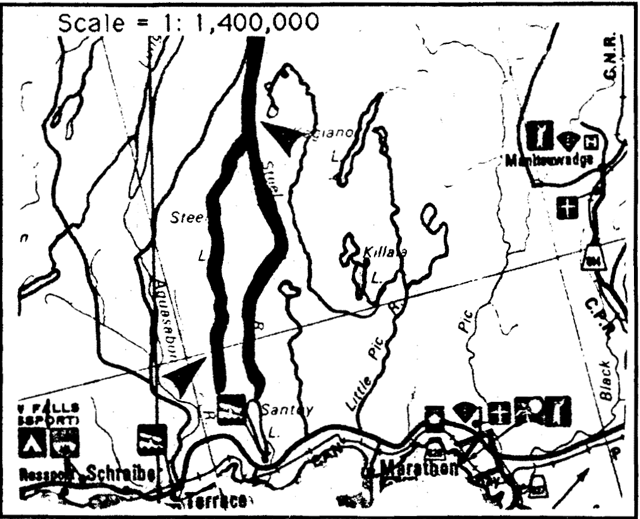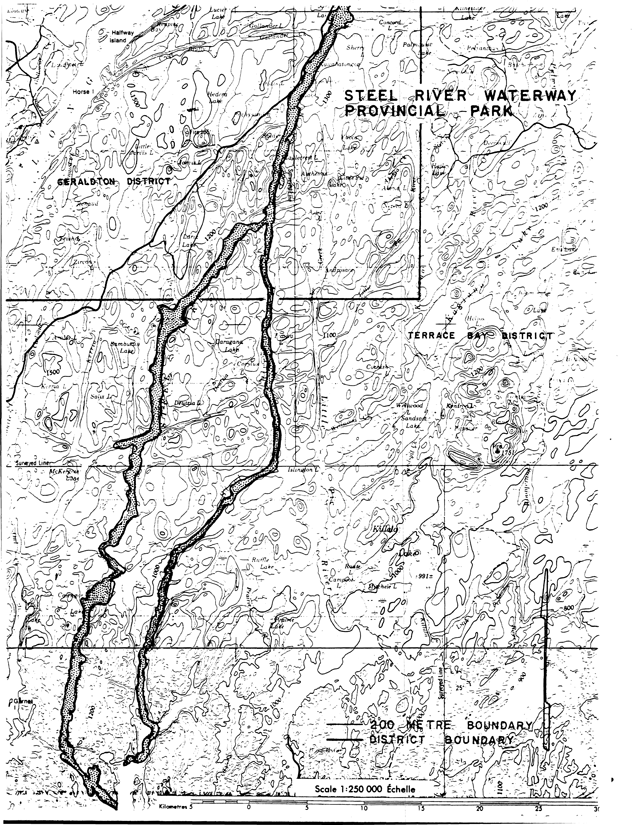Steel River Provincial Park Management Statement
This document provides policy direction for the protection, development and management of Steel River Provincial Park and its resources.
© 1991 Government of Ontario
Regional Director’s approval statement
Steel River Waterway Provincial Park
This revised Interim Management Statement will provide interim direction for the management of the above Provincial Park until a comprehensive Park Management Plan is prepared.
This statement will provide the basis for the subsequent preparation of the Park Management Plan.
I am pleased to approve this Interim Management Statement.
S. Millar
A/Regional Director
North Central Region
Revised March 1991
Background information
- Name: Steel River
- Class: Waterway
- Date: 8.05.89
- MNR district: Terrace Bay
- MNR region: North Central
- Total Area (ha): 10,572
- Site region: 3W
- Site district: 4, 5
- Date in regulation: May 8, 1989
A 1:1,400,000 scale map of Steel River Provincial Park

Life science representation targets
- Site type/ landscape unit: esker complex; lacustrine valley train deposit; shallow sandy till over Archean bedrock
- Species/communities: associated vegetation communities
Earth science representation
- Geological theme: Timiskaming Interstadial Island arcs basin
- Feature: Valley train deposits In post-glacial spillway, Wawa belt representation (cross section)
Cultural resource representation
- Theme: Unknown
- Theme segment: N/A
Recreation opportunities
- Day use: N/A
- Car camping: N/A
- Wilderness/back country: 5,625
| Level/Type | Reconnaissance/ completion date | Detailed completion date | Required? |
|---|---|---|---|
| life science | checksheet | N/A | detailed inventory |
| earth science | checksheet | N/A | detailed inventory |
| cultural | N/A | N/A | brief survey |
| recreational | N/A | N/A | N/A |
| other | N/A | N/A | N/A |
Steel River Waterway Provincial Park interim management statement
I Land tenure
All land within the Park is Crown Land. The cottage locations on the north shore of Santoy Lake are not included in the park.
Guideline:
No other forms of tenure exist within the park
II Land acquisition/disposition
There is no patented land within the Park area.
Guideline:
Land acquisition/disposition will not be considered.
III Existing/proposed development
Present development consists of approximately 19 portages and 20 campsites situated along the waterway. Two forest access roads cross the system, with the possibility of a third crossing in the future. Seven access points allow for various trip lengths, with a choice of fast-water or slow-river travel, or lake travel.
Guideline:
The MNR will maintain campsites and portages as funding permits. The additional crossing between Steel Lake and Cairngorm Lake, if deemed necessary will be subject to the Field Environmental Procedure and Guidelines.
IV Recreational activities
The park presently receives moderate use from canoeists and sport fishermen, mainly during the May to September period. Present uses vary from lone canoeists to groups fishing with power boats. There is some fly-in use of the area by commercial outfitters. Two boat caches are located in the Steel Lake area.
Guideline:
A user survey/registration system will be developed at major access points to monitor present use, and to provide information for management planning strategies on items such as:
- motorized recreational travel (powerboats) vs. wilderness recreational activities (canoes).
- boat caches
- can and bottle ban
- aircraft access
- all-terrain vehicle, snowmobile use
Subject to appropriate legislation, existing recreational uses will be permitted to continue. No new boat caches will be permitted.
V Commercial activities
Tourism
Commercial tourism use presently consists of occasional air access/ pick-up services for sport fishermen, hunters and canoe parties. There are no commercial outpost camps or lodges within the park.
Guideline:
Fly-in use will continue to be permitted, subject to the Provincial Parks Act and Regulations. Development such as outpost camps will not be permitted.
Trapping
Parts of four commercial fur traplines and two trapline cabins are situated in the park area.
Guideline:
Trapline cabins will be permitted to remain, pending completion of a park management plan. No new trapline cabins will be permitted in the park area.
Trapping will be allowed to continue only for Status Indians enjoying treaty rights. Otherwise it will be phased out by January 1, 2010 or when the trapper retires or dies, whichever is sooner.
Forestry, commercial fishing, mining and aggregate extraction will not be permitted in the Park.
Other commercial activities will not be permitted.
VI Natural resources
The Steel River Waterway Park encompasses a 220 m corridor along each side of the Steel Lake and River system north of Santoy Lake, including Diablo Lake on the south and Grehan Lake at the north boundary. This 160 km waterway system has a combined land and water area of 10,572 ha and is a designated Provincial canoe route with three separate published trips. A crown reserve, in effect since 1976, has served to protect the shoreline of the river.
The Park offers backcountry recreational opportunities in an area of contrasting landscapes and varying water features while providing protection for the cultural and natural features of the waterway.
Mineral and aggregate management
Significant mineral/aggregate removals have not previously occurred within the park area.
Guideline:
Mineral exploration/extraction and aggregate extraction will not be permitted in the park area.
Vegetation management
Commercial timber harvesting has not occurred within the former shoreline reserve, although two roads presently cross the water system providing access to timber operating areas.
Guideline:
Commercial timber harvesting will not be permitted within the park. Areas outside of the park, which if logged could affect park values, will be identified and dealt with by Areas of Concern during the reviews of timber operating and annual plans.
An additional road crossing between Steel and Cairngorm Lakes may be permitted to facilitate timber harvesting in the area west of these lakes. Any roads within 400m of the park bound ary will have an indiv idual strategy prepared to address: the length of time that the road is needed; location of the road; signage to prevent access to the park and action to be taken when the road is no longer required. Industry co operation will be sought to reduce the noise impact from logging operations on park visitors.
Fisheries management
The park offers good to excellent sport fishing opportunities, and much of the use received by the park is associated with this activity. The park area contains several (mostly inactive) bait fish areas.
Guideline
Both sport fishing commercial bait fishing operations will continue to be permitted. Commercial fishing will not be permitted.
Wildlife management
The park receives limited hunting pressure due mainly to its inaccessibility.
Guideline:
Hunting will be permitted within the park.
VII Cultural resources
The Steel River is believed to have been used as a minor supply/ fur-trading route of the 1800s. One Indian burialsite has been documented. The canoe route was first advertised by the Canadian Pacific Railway in the 1890s.
Guideline:
A detailed inventory of cultural resourcns will be undertaken prior to completion of a Management Plan. Any disturbance to potential and/or identified cultural resources within the Park will be discouraged and restrictions on activities on or near the sites will be implemented if necessary.
VIII Client services
The only client service provided at the present time is the provision of canoe route informational brochures.
Guideline:
Canoe route informational brochures will continue to be made available to the public, as long existing supplies remain. If funds are available, existing brochures will be updated and improved.
IX Research/inventories
Guideline:
Detailed earth/life science and cultural resource inventories will be conducted prior to completion of a Management Plan.
References/Sources
O.M.N.R. 1983. Terrace Bay District Land Use Guidelines.
A 1:250,000 scale map of Steel River Provincial Park
